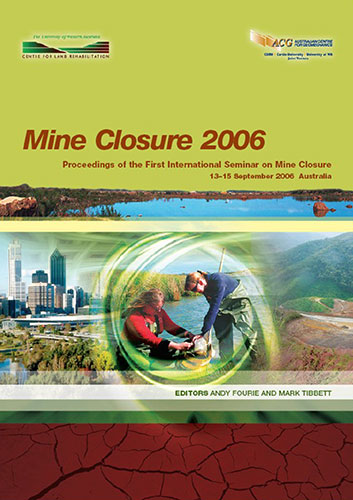Calculating a Realistic Security Bond and Assessing True Mine Closure Liabilities

|
Authors: Woolley, M; Hutton, A |
DOI https://doi.org/10.36487/ACG_repo/605_45
Cite As:
Woolley, M & Hutton, A 2006, 'Calculating a Realistic Security Bond and Assessing True Mine Closure Liabilities', in AB Fourie & M Tibbett (eds), Mine Closure 2006: Proceedings of the First International Seminar on Mine Closure, Australian Centre for Geomechanics, Perth, pp. 525-535, https://doi.org/10.36487/ACG_repo/605_45
Abstract:
During the 1990s a number of mine operators in NSW, Australia became insolvent and mining leases, along with the closure and rehabilitation liabilities, were passed back to the government. In many cases it was found that the Security Bond held by the government represented only a small portion of the actual amount required to effectively close the operations to appropriate environmental and public safety standards. Accordingly, where no alternative was identified, these mines were managed by the Department of Primary Industries - Mineral Resources (DPI-MR) as part of their Derelict Mines Program (DMP). Even when supplemented by DMP funds, there was frequently insufficient money for full or even adequate rehabilitation and the works undertaken were generally to make the site safe. Derelict mines continue to burden NSW taxpayers as well as being a public safety and environmental risk. Their legacies arguably represent a risk to the mining industries public licence to operate and to the image of sustainable mining practices throughout Australia generally. With the aim of investigating potential underlying causes for the failure of the government to hold sufficient security for closure, the DPI-MR commissioned URS to undertake a study into their security review process including benchmarking of processes against other agencies in Australia and worldwide. A number of findings were made, including that the majority of agencies did not hold sufficient securities to cover potential mine closure liabilities. A key recommendation was that mine operators should have the responsibility for “self assessment” of the total costs required for rehabilitation and closure of the mine. Operator cost estimates would then be reviewed by the DPI-MR and set as the security bond for the operation. Consequently a Rehabilitation Cost Estimate Tool was developed by URS/GSSE to enable a thorough and consistent approach for all NSW mine sites to use in the estimation of closure liabilities. The cost estimation approach would form a minimum standard for establishing an appropriate security bond for the site. The Tool is now being used as a basis for closure cost assessment in NSW and following some modification, is currently being trial for use by the Victorian DPI in their management of mines and extractive industries. This paper explores the inaccuracies of past bond estimation methodologies, particularly in relation to the under estimation of the security bonds and also includes the findings of the benchmarking review. A summary is provided of the approach taken in development of the Rehabilitation Cost Estimate Tool for NSW as well as discussion on how the Tool was modified to fit the Victorian context. In conclusion, recommendations are made for the industry going forward based on the feedback from the state agencies, industry groups and the mine operators alike.
References:
URS Australia (2004) Options Assessment Paper, Review of Security Bond Estimation Processes.
URS Australia (2002) Review of Mine Rehabilitation Security Processes.
NSW Department of Primary Industries (2005) Managing Derelict Mines, Primefact 22.
Financing Closure
Mine Closure 2006, Perth, Australia 535
© Copyright 2025, Australian Centre for Geomechanics (ACG), The University of Western Australia. All rights reserved.
View copyright/legal information
Please direct any queries or error reports to repository-acg@uwa.edu.au
View copyright/legal information
Please direct any queries or error reports to repository-acg@uwa.edu.au